Radio Shack 980 User Manual
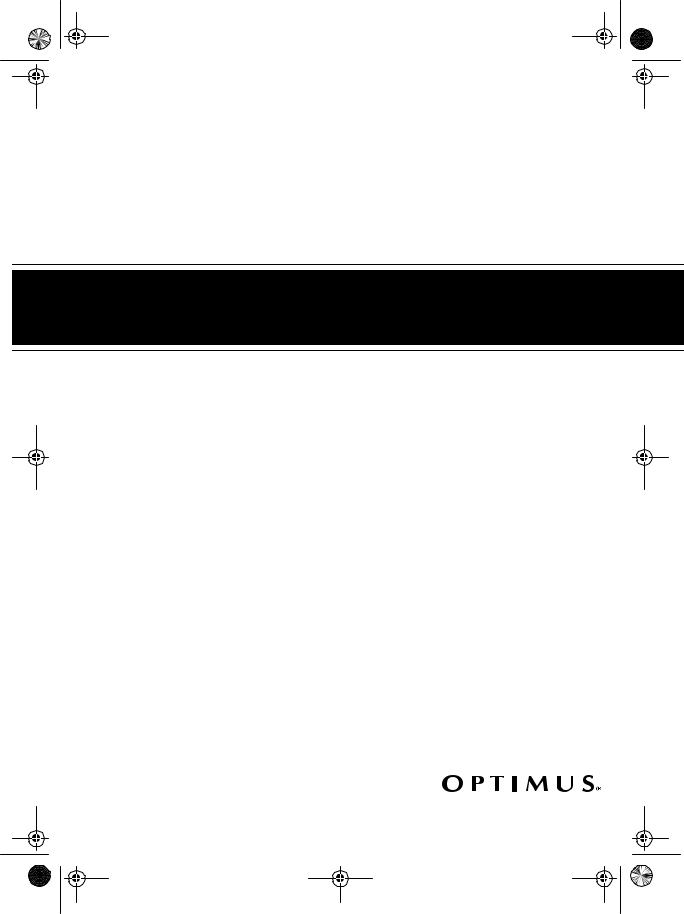
42-4038.fm Page 1 Thursday, August 12, 1999 8:50 AM
Cat. No. 42-4038
OWNER’S MANUAL
Please read before using this equipment.
Concertmate® 980
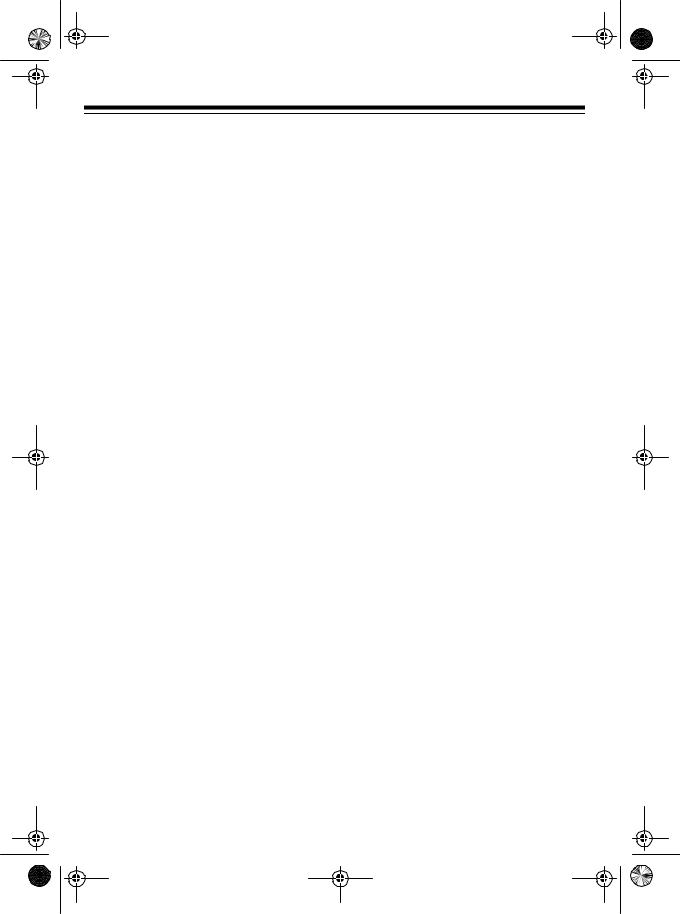
42-4038.fm Page 2 Thursday, August 12, 1999 8:50 AM
FEATURES
Your Optimus Concertmate 980 is a state-of-the-art keyboard with many exciting features. You can set the keyboard to sound like 100 different musical instruments or sound effects. To accompany your music, the keyboard has 100 rhythms, as well as auto accompaniments and percussion sounds.
Your keyboard also includes a MIDI (Musical Instrument Digital Interface) feature, which lets you connect it to other MIDI-equipped musical instruments or devices, even your personal computer.
This versatile keyboard can provide hours of fun and is ideal for anyone who wants to make music, from the beginner to the experienced musician.
Note: The Concertmate 980 conforms to most, but not all, General MIDI specifications. Because of this, you might experience some incompatibility when using the Concertmate 980 with another General MIDI device. For more information, see “Using MIDI” on Page 25.
Your keyboard’s features include:
100 Prerecorded Tunes — let you hear a sample of what you and the keyboard can do. You can play the tunes either one at a time or consecutively, and you can turn off the melody or accompaniment portion so you can play along with the tunes.
100 Tones — you can set your keyboard to sound like anything from a harpsichord to a honky-tonk piano.
12-Note Polyphonic Sound — lets you play and hear up to 12 notes at the same time so you can play or create almost any type of music.
Tempo Control — lets you speed up or slow down the tempo of any selected music pattern.
100 Auto-Rhythms — give you a steady beat for many styles of music, from rhumba to slow rock.
Fill-In Rhythm — lets you insert a short variation into any auto-rhythm.
Auto Accompaniment — lets you automatically play a preset harmonic pattern to match the selected auto-rhythm.
Tune Control — lets you adjust the pitch of your keyboard so you can play in tune with other instruments.
Transpose Function — lets you instantly change the key of the music, even while you are playing.
Chord Book — lets you easily see which keys to press and which fingers to use to form a chord, as well as a chord’s name.
Two Built-In Speakers — provide excellent sound to help make your music come alive.
©1998 Tandy Corporation. All Rights Reserved.
Concertmate, Optimus, and RadioShack are registered trademarks used by Tandy Corporation.
2
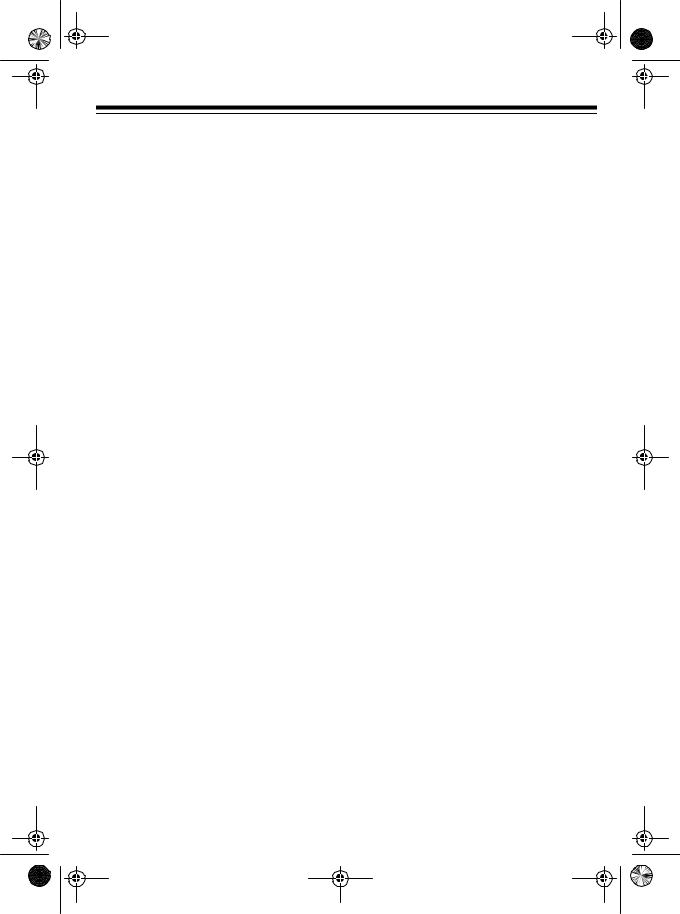
42-4038.fm Page 3 Thursday, August 12, 1999 8:50 AM
Headphones/Output Jack — lets you connect headphones so you can play without disturbing others, or an external amplifier so you can play for a crowd.
Sustain Jack — lets you connect a sustain pedal (not supplied) to the Concertmate 980 so you can sustain your keyboard’s sound.
Three Power Options — let you power the keyboard from internal batteries (not supplied), standard AC power (with an optional adapter), or your vehicle’s ciga- rette-lighter socket (with an optional adapter) so you can make music almost anywhere.
To fully enjoy the features and functions of this electronic keyboard, please read this manual carefully and completely.
Notes:
•If the keyboard is left in one place for a very long time, its feet could mar your furniture’s finish. We recommend you place the feet on felt cloth pads to protect your furniture or use an optional keyboard stand such as RadioShack Cat. No. 424050.
•This owner’s manual explains how to use this electronic keyboard. It does not teach music.
We recommend you record your keyboard’s serial number here. The number is in the battery compartment of the keyboard.
Serial Number _________________
THE FCC WANTS YOU TO KNOW
This keyboard complies with the limits for a Class B digital device as specified in Part 15 of FCC Rules. These limits provide reasonable protection against radio and TV interference in a residential area. However, your keyboard might cause TV or radio interference even when it is operating properly. To eliminate interference, you can try one or more of the following corrective measures:
•Reorient or relocate the receiving antenna.
•Increase the distance between the keyboard and the radio or TV.
•Use outlets on different electrical circuits for the keyboard and the radio or TV.
Consult your local RadioShack store if the problem still exists.
You must use shielded interface cables with this equipment.
3
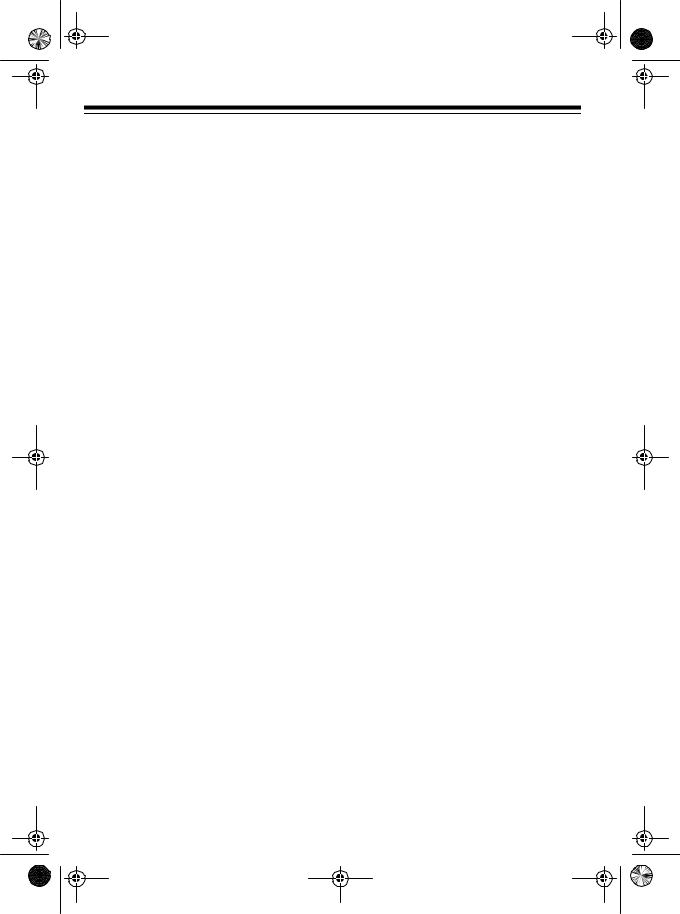
42-4038.fm Page 4 Thursday, August 12, 1999 8:50 AM
CONTENTS |
|
Preparation .............................................................................................................. |
6 |
Connecting Power .............................................................................................. |
6 |
Using Batteries ............................................................................................. |
6 |
Using AC Power ........................................................................................... |
7 |
Using Vehicle Battery Power ........................................................................ |
7 |
Connecting Headphones .................................................................................... |
8 |
Listening Safely ............................................................................................ |
8 |
Connecting an External Amplifier ....................................................................... |
8 |
Using the Sheet Music Stand ............................................................................. |
9 |
Control Locations ................................................................................................. |
10 |
Operation ............................................................................................................... |
11 |
Basic Operation ................................................................................................ |
11 |
Cancelling Auto Power Off ......................................................................... |
11 |
Playing the Prerecorded Tunes ........................................................................ |
12 |
Playing Back a Prerecorded Tune ............................................................. |
12 |
Playing Along with a Prerecorded Tune ..................................................... |
14 |
Turning Applause Off/On ........................................................................... |
14 |
Consecutively Playing Back the Tunes ...................................................... |
14 |
Using the Preset Tones .................................................................................... |
15 |
Selecting/Playing a Preset Tone ................................................................ |
15 |
Keyboard Split Tones ................................................................................. |
16 |
Layered Tones ........................................................................................... |
16 |
Percussion Sounds .................................................................................... |
16 |
Using the Preset Auto-Rhythms ....................................................................... |
17 |
Selecting/Playing an Auto-Rhythm ............................................................ |
17 |
Using SYNCHRO ....................................................................................... |
18 |
Using FILL-IN ............................................................................................. |
18 |
Using Auto Accompaniment ............................................................................. |
18 |
Adjusting the Accompaniment Volume ...................................................... |
19 |
Concert Chord ............................................................................................ |
19 |
Standard Fingering .................................................................................... |
20 |
Using the Chord Book ...................................................................................... |
21 |
Special Features ................................................................................................... |
23 |
Changing Keys ................................................................................................. |
23 |
Tuning the Keyboard ........................................................................................ |
24 |
Using a Sustain Pedal ...................................................................................... |
24 |
4
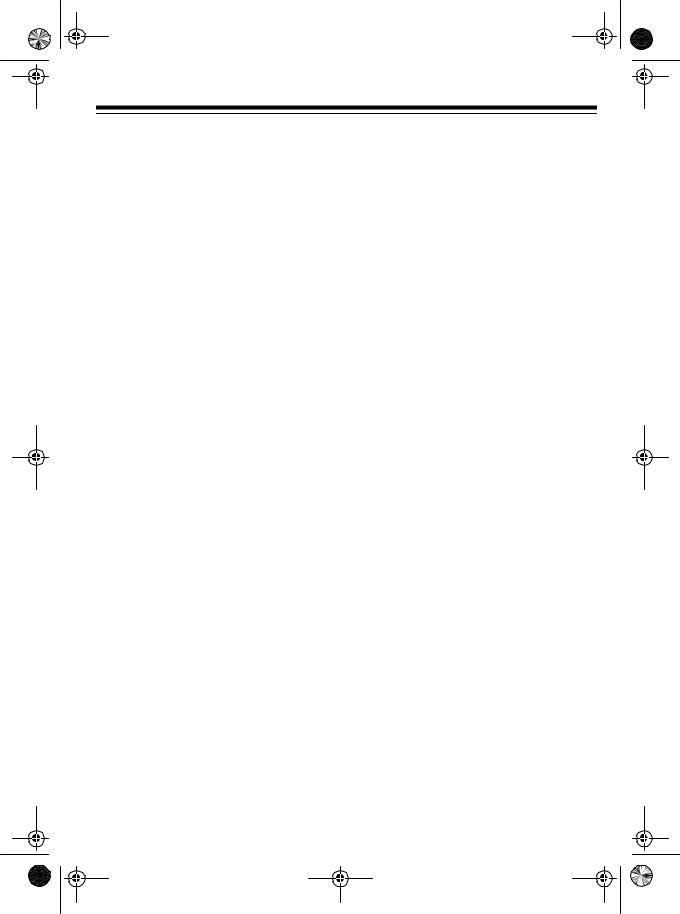
42-4038.fm Page 5 Thursday, August 12, 1999 8:50 AM
Using MIDI ............................................................................................................. |
25 |
About MIDI ....................................................................................................... |
25 |
Making the MIDI Connections .......................................................................... |
25 |
MIDI Data ......................................................................................................... |
26 |
Changing MIDI Settings ................................................................................... |
27 |
Notes About the MIDI Implementation Chart .................................................... |
27 |
Troubleshooting .................................................................................................... |
29 |
Standard Fingering Chord Charts ....................................................................... |
31 |
Note Table .............................................................................................................. |
34 |
MIDI Implementation Chart .................................................................................. |
36 |
Care and Maintenance .......................................................................................... |
38 |
Specifications ....................................................................................................... |
39 |
5
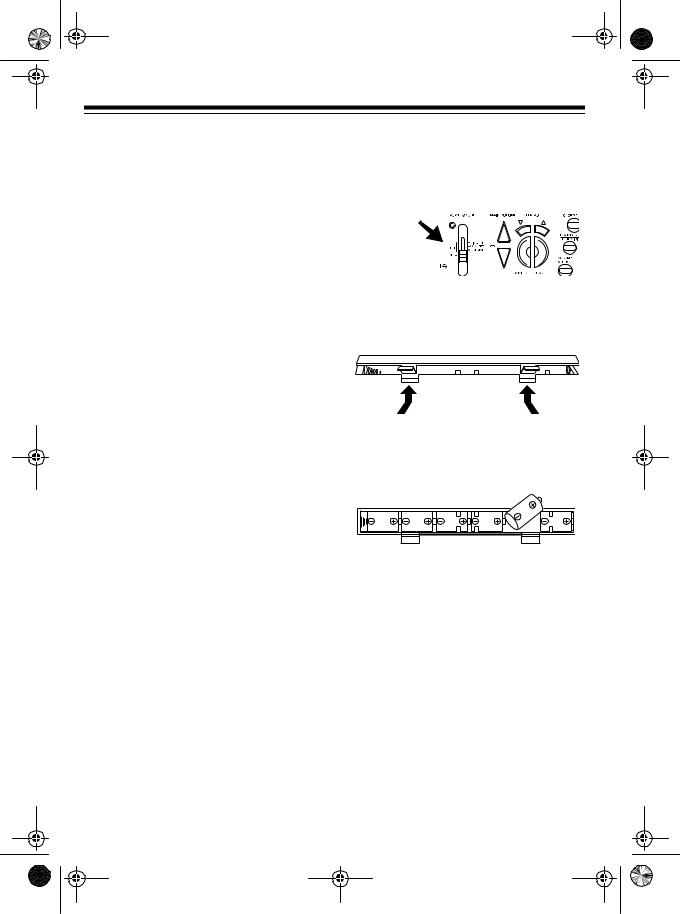
42-4038.fm Page 6 Thursday, August 12, 1999 8:50 AM
PREPARATION
Note: To connect a MIDI device to your |
rechargeable batteries of different |
keyboard, see “Making the MIDI Connec- |
capacities. |
tions” on Page 25. |
|
|
1. Set POWER/MODE to OFF. |
CONNECTING POWER
You can power your keyboard in any of these ways:
•internal batteries
•standard AC power using an optional AC adapter
•a vehicle’s cigarette-lighter socket using an optional DC adapter
Notes:
•Connecting an AC or DC adapter automatically disconnects any internal batteries.
•Always disconnect the AC or DC adapter when you finish using the keyboard.
2.While pressing both tabs on the battery compartment cover on the bottom of the keyboard, pull the cover up to remove it.
3.Put six D batteries into the compartment as indicated by the polarity symbols (+ and –) marked below the compartment.
Using Batteries
Your keyboard can use six D batteries (not supplied) for power. For the best performance, we recommend alkaline batteries, such as RadioShack Cat. No. 23-550.
Cautions:
•Use only fresh batteries of the required size and recommended type.
•Do not mix old and new batteries, different types of batteries (standard, alkaline, or rechargeable), or
6
4. Replace the cover.
When the keyboard stops operating properly, replace all six batteries.
Cautions:
•If you do not plan to use the keyboard for a week or more, or if you plan to use only an AC or DC adapter, remove the batteries. Batteries can leak chemicals that can destroy electronic parts.
•Dispose of old batteries promptly and properly. Do not burn or bury them.
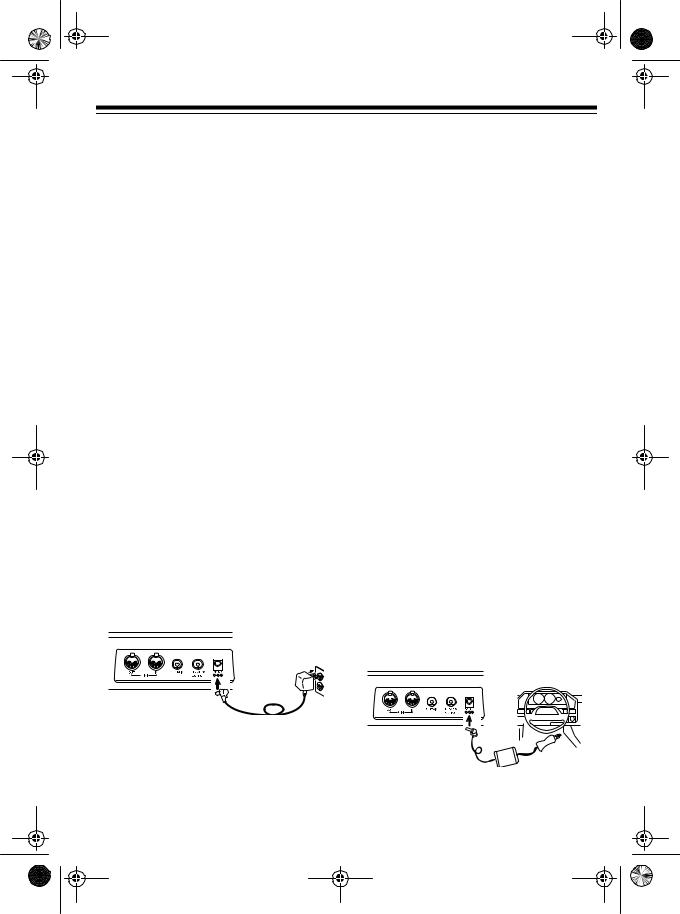
42-4038.fm Page 7 Thursday, August 12, 1999 8:50 AM
Using AC Power
You can power your keyboard from standard AC power using an optional 9- volt AC adapter (such as RadioShack Cat. No. 273-1656).
Cautions:
•You must use an AC adapter that supplies 9 volts and delivers at least 800 mA. Its center tip must be set to negative and its plug must fit the keyboard’s DC 9V jack. The recommended adapter meets these specifications. Using an adapter that does not meet these specifications could damage the keyboard or the adapter.
•Always plug the AC adapter into the keyboard before you plug it into the AC outlet. Always unplug the AC adapter from the AC outlet before you unplug it from the keyboard.
•Be sure POWER/MODE is set to OFF before you connect or disconnect the adapter.
Follow these steps to connect an AC adapter to the keyboard.
1.Connect the AC adapter’s 5.5 mm outer diameter/2.1 mm inner diameter barrel plug to the DC 9V jack on the back of the keyboard.
2.Plug the AC adapter’s other end into a standard AC outlet.
Using Vehicle Battery Power
You can power your keyboard from your vehicle’s cigarette-lighter socket using an optional 9-volt DC adapter (such as RadioShack Cat. No. 273-1815).
Cautions:
•You must use a DC adapter that supplies 9 volts and delivers at least 800 mA. Its center tip must be set to negative and its plug must fit the keyboard’s DC 9V jack. Using an adapter that does not meet these specifications could damage the keyboard or the adapter.
•Always plug the DC adapter into the keyboard before you plug it into the cigarette-lighter socket. Always unplug the DC adapter from the cigarette-lighter socket before you unplug it from the keyboard.
•Be sure POWER/MODE is set to OFF before you connect or disconnect the adapter.
Follow these steps to connect a DC adapter to the keyboard.
7
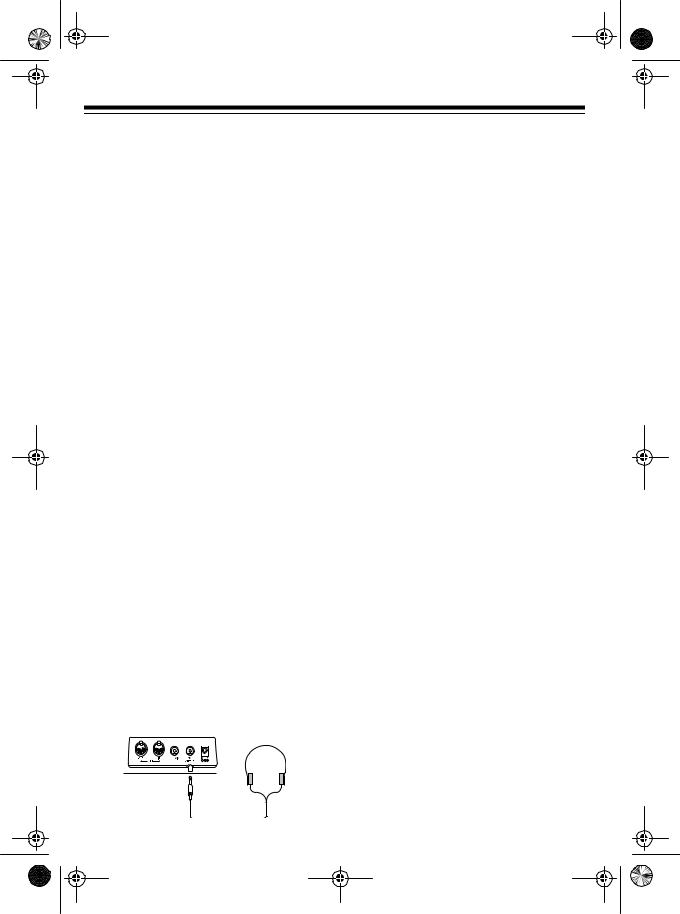
42-4038.fm Page 8 Thursday, August 12, 1999 8:50 AM
1.Plug the DC adapter’s 5.5 mm outer diameter/2.1 mm inner diameter barrel plug into the cable so it reads
– TIP.
2.Set the DC adapter’s voltage switch to 9 volts.
3.Connect the DC adapter’s barrel plug to the DC 9V jack on the back of the keyboard.
4.Plug the DC adapter’s other end into your vehicle’s cigarette-lighter socket.
Note: If the keyboard does not operate when you use the DC adapter, unplug the cord from the cigarette-lighter socket and clean any ashes or debris from the socket. If your keyboard still does not work, check the fuse in the DC adapter and replace it if necessary.
Note: Connecting headphones disconnects the keyboard’s built-in speakers.
Listening Safely
To protect your hearing, follow these guidelines when you use headphones.
•Set the volume to the lowest setting before you begin listening. After you begin listening, adjust the volume to a comfortable level.
•Do not listen at extremely high volume levels. Extended high-volume listening can lead to permanent hearing loss.
•Once you set the volume, do not increase it. Over time, your ears adapt to the volume level, so a volume level that does not cause discomfort might still damage your hearing.
CONNECTING
HEADPHONES
To listen to your keyboard without disturbing others, you can connect an optional pair of stereo headphones with a 1/4-inch (6.4-mm) plug. Your local RadioShack store sells a wide selection of headphones.
Insert the headphones’ plug into the PHONES/OUTPUT jack on the back of the keyboard.
8
CONNECTING AN EXTERNAL AMPLIFIER
To amplify your keyboard’s sound, you can connect it to an optional external amplifier using an audio cable with a 1/4- inch (6.4-mm) plug (not supplied).
To connect an external amplifier to your keyboard, insert the cable’s plug into the PHONES/OUTPUT jack on the back of the keyboard, and connect the cable’s other end to the amplifier’s input jack(s) (such as AUX IN or TAPE IN).
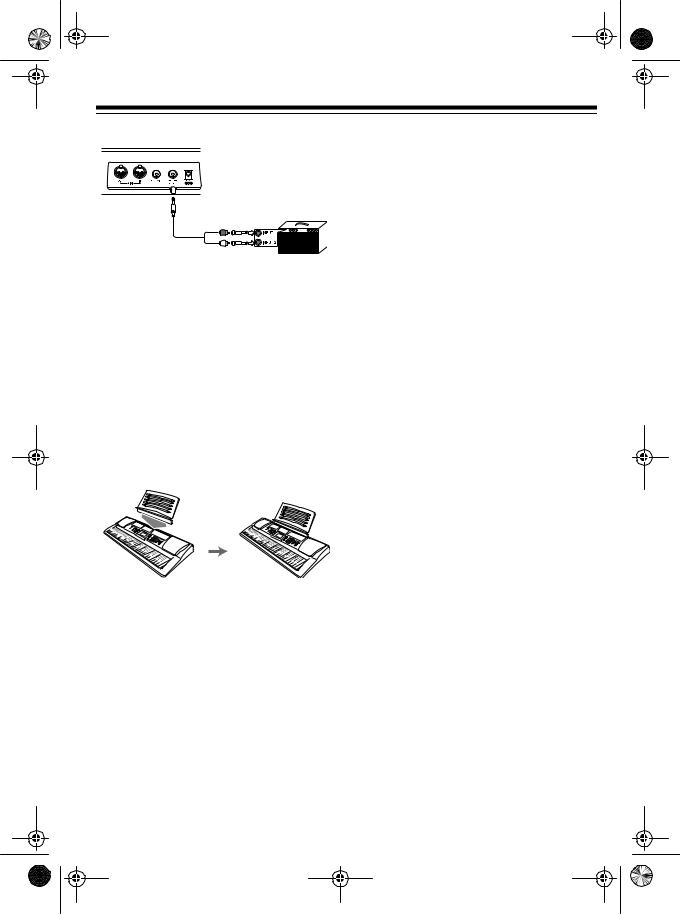
42-4038.fm Page 9 Thursday, August 12, 1999 8:50 AM
Your local RadioShack store sells a full line of amplifiers, speakers, and connection cables.
USING THE SHEET MUSIC
STAND
To easily view sheet music while playing your keyboard, insert the supplied sheet music stand into the slot on the top back panel.
9
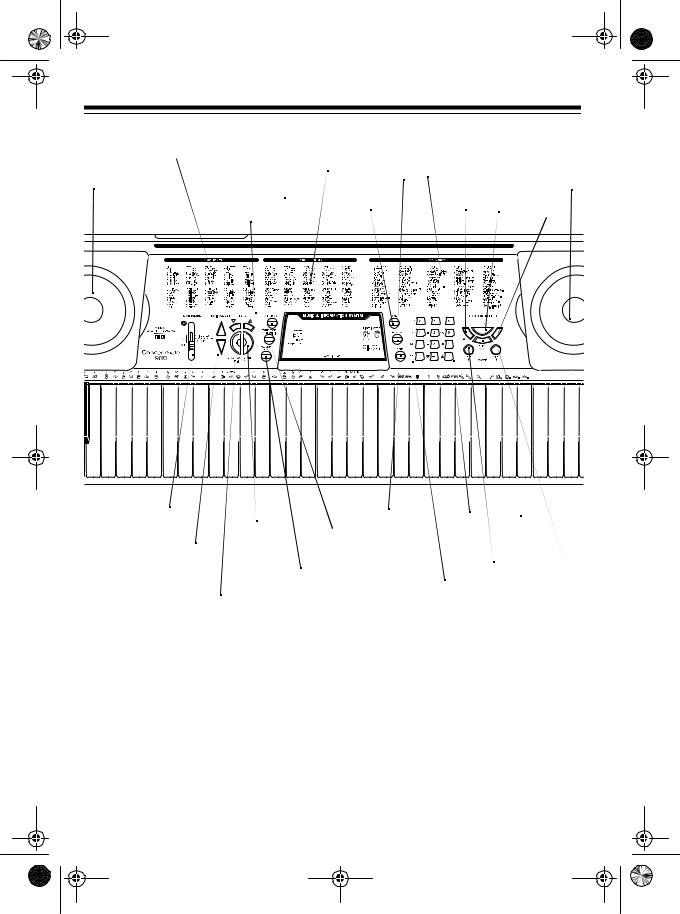
42-4038.fm Page 10 Thursday, August 12, 1999 8:50 AM
CONTROL LOCATIONS
100 TONES List |
100 RHYTHMS List |
|
100 SONGS List |
|
Speaker |
|
|||
CHORD BOOK |
RHYTHM |
|
Speaker |
|
|
|
|
|
|
|
|
TONE |
REW |
STOP |
|
TEMPO |
|
FF |
|
|
|
|
|
|
|
|
|
|
|
|
|
|
|
|
|
|
|
|
|
|
|
|
|
|
|
|
|
|
|
|
|
|
|
|
|
|
|
|
|
|
|
|
|
|
|
|
|
|
|
|
|
|
|
|
|
|
|
|
|
|
|
|
|
|
|
|
|
|
|
|
|
|
|
|
|
|
|
|
|
|
|
|
|
|
|
|
|
|
|
|
|
|
|
|
|
|
|
|
|
|
|
|
|
|
|
|
|
|
|
|
|
|
|
|
|
|
|
|
|
|
|
|
|
|
|
|
|
|
|
|
|
|
|
|
|
|
|
|
|
|
|
|
|
|
|
|
|
|
|
|
|
|
|
|
|
|
|
|
|
|
|
|
|
|
|
|
|
|
|
|
|
|
|
|
|
|
|
|
|
|
|
|
|
|
|
|
|
|
|
|
|
|
|
|
|
|
|
|
|
|
|
|
|
|
|
|
|
|
|
|
|
|
|
|
|
|
|
|
|
|
|
|
|
|
|
|
|
|
|
|
|
|
|
|
|
|
|
|
|
|
|
|
|
|
|
|
|
|
|
|
|
|
|
|
|
|
|
|
|
|
|
|
|
|
|
|
|
|
|
|
|
|
|
|
|
|
|
|
|
|
|
|
|
|
|
|
|
|
|
|
|
|
|
|
|
|
|
|
|
|
|
|
|
|
|
|
|
|
|
|
|
|
|
|
|
|
|
|
|
|
|
|
|
|
|
|
|
|
|
|
|
|
|
|
|
|
|
|
|
|
|
|
|
|
|
|
|
|
|
|
|
|
|
|
|
|
|
|
|
|
|
|
|
|
|
|
|
|
|
|
|
|
|
|
|
|
|
|
|
|
|
|
|
|
|
|
|
|
|
|
|
|
|
|
|
|
|
|
|
|
|
|
|
|
|
|
|
|
|
|
|
|
|
|
|
|
|
|
|
|
|
|
|
|
|
|
|
|
|
|
|
|
|
|
|
|
|
|
|
|
|
|
|
|
|
|
|
|
|
|
|
|
|
|
|
|
|
|
|
|
|
|
|
|
|
|
|
|
|
|
|
|
POWER/MODE |
|
|
SONG |
|
|
|
|
|
|
|
|
|
|
|
|
|
|
|
|
|
|
|
|
|
|||||||||||||||||||||||||||
|
|
|
|
|
|
|
|
|
|
|
|
|
|
|
|
|
|
|
|
|
|
|
|
|
|
_/+ |
|
|
|
|
|
|
|
|
|
|
|||||||||||||||
|
|
|
|
|
|
|
|
|
|
|
|
|
|
START/ |
|
|
|
|
|
|
|
|
|
PLAY/ |
|
|
|
|
|
||||||||||||||||||||||
|
|
|
|
|
|
|
|
|
|
|
|
|
|
TRANSPOSE/ |
|
|
|
|
|
|
|
|
|
|
|
|
|
PAUSE |
|||||||||||||||||||||||
|
|
|
|
|
|
|
|
|
|
|
|
|
|
STOP |
|
|
|
|
|
|
|
|
|
|
|
|
|
||||||||||||||||||||||||
|
|
MAIN VOLUME |
TUNE/MIDI |
|
|
|
|
|
|
|
|
|
|
|
|
|
|
|
|
|
|
|
|
|
|||||||||||||||||||||||||||
|
|
|
|
|
|
|
|
|
|
|
|
|
|
|
|
|
|
|
ACCOMP |
|
|
|
|
|
|
|
|
|
|
|
|
|
|
|
|
|
|
LEFT |
|
|
|
|
|
||||||||
|
|
|
|
|
|
|
|
|
|
|
|
|
|
|
|
|
|
|
|
|
|
|
|
|
|
|
Number |
ON/OFF |
RIGHT |
||||||||||||||||||||||
|
|
|
|
|
|
|
|
|
|
|
|
|
|
|
|
|
|
|
VOLUME |
|
|
|
|
|
|
|
|
|
|
|
|
|
|||||||||||||||||||
|
|
|
|
|
|
|
|
|
|
|
|
|
|
|
|
|
|
|
|
|
|
|
|
|
|
|
|
|
|
|
|
ON/OFF |
|||||||||||||||||||
|
|
|
|
|
|
|
|
|
|
|
|
|
|
|
|
|
|
|
|
|
|
|
|
|
|
|
Keys |
|
|
|
|
|
|||||||||||||||||||
|
|
|
|
|
|
SYNCHRO/ |
|
|
|
|
|
|
|
|
|
|
|
|
|
|
|
|
|
|
|||||||||||||||||||||||||||
FILL-IN
10
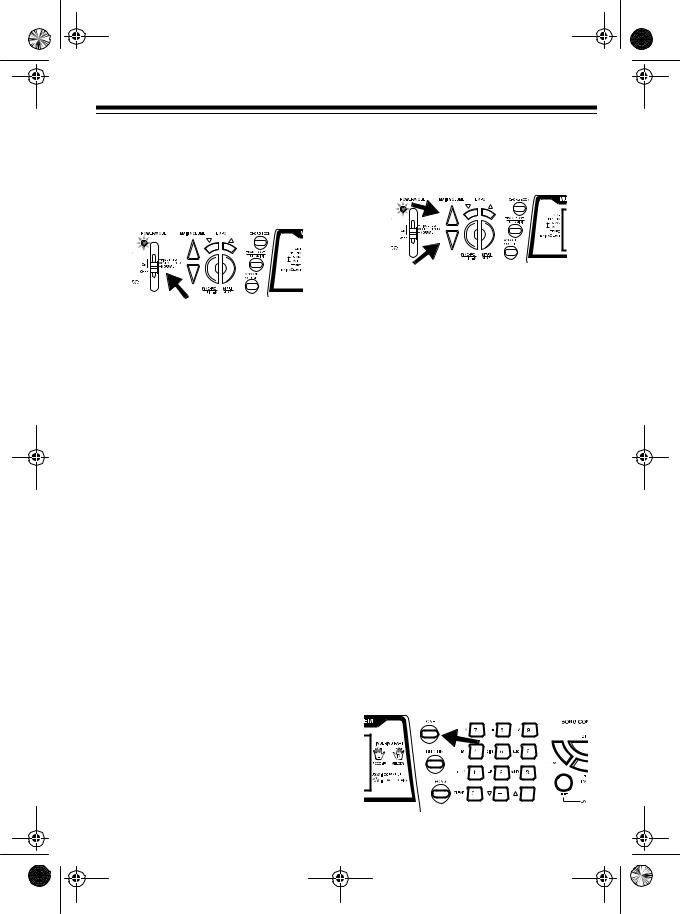
42-4038.fm Page 11 Thursday, August 12, 1999 8:50 AM
OPERATION
BASIC OPERATION
1.To turn on the keyboard, set
POWER/MODE to NORMAL. The POWER/MODE indicator lights.
Note: To save power when operating on batteries, the keyboard automatically turns off after about 6 minutes if you do not press a key. To turn on the keyboard again, set
POWER/MODE to OFF then back to NORMAL.
2.To hear a sample of the Concertmate 980’s many sounds, play a prerecorded tune (see “Playing the Prerecorded Tunes” on Page 12). To make your own music, simply begin playing the keyboard.
Notes:
•The keyboard automatically selects the tone PIANO 1 (No. 00) when you turn the power on. To select a different tone, see “Selecting/Playing a Preset Tone” on Page 15.
•To select an auto-rhythm, see “Using the Preset Auto-Rhythms” on Page 17.
•To play auto accompaniment, see “Using Auto Accompaniment” on Page 18.
3.Repeatedly press MAIN VOLUME s or t to increase or decrease the volume. The current setting ap-pears.
Notes:
•The keyboard’s volume ranges from 0 (no sound) to 9 (maximum). Each time you turn on the keyboard, the volume is set to 7.
•To quickly change the volume setting, hold down MAIN VOLUME s or t.
•To quickly return to the default volume setting of 7, press both MAIN VOLUME buttons at the same time.
•The volume level differs depending on the tone, accompaniment, or song you selected.
4.To turn off the keyboard, set
POWER/MODE to OFF. The POWER/ MODE indicator turns off.
Cancelling Auto Power Off
To have the keyboard not automatically turn off during a session, turn on the keyboard while holding down TONE.
11
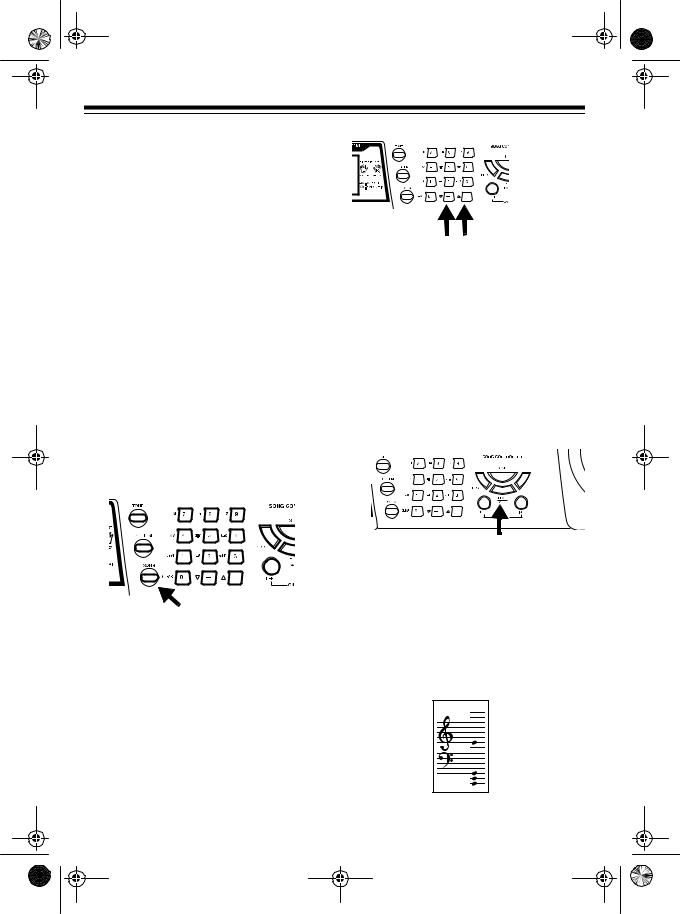
42-4038.fm Page 12 Thursday, August 12, 1999 8:50 AM
The next time you turn the keyboard off then back on again, it will automatically turn off after about 6 minutes.
PLAYING THE PRERECORDED TUNES
You can sit back and listen to the 100 tunes that come prerecorded in the keyboard, or you can turn off a tune’s melody or accompaniment and play along on the keyboard.
Playing Back a Prerecorded
Tune
1.Press SONG. An indicator appears next to SONG on the display and the number of the current tune appears.
Notes:
•Precede a single-digit number with a 0. For example, to select 07 (“Killing Me Softly with His Song”) press 0 7.
•If you enter an incorrect first digit, press SONG to clear your entry, then enter the correct digit.
3.Press PLAY/PAUSE to start playing the tune.
Note: The keyboard always selects the tune “How Deep is Your Love” (No. 00) the first time you press SONG after turning the power on.
2.Choose a tune from the 100 SONGS list and enter its two-digit number on the keypad.
Or, you can press – or + to move to the next higher or lower numbered tune.
12
You can change the tune by repeating Step 2 even while a tune is playing. The new tune immediately begins to play.
As a tune plays, the display shows:
•a “score” to show you the notes that are playing (right side of the display)
